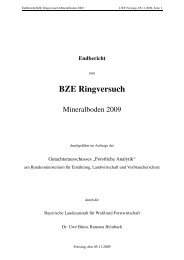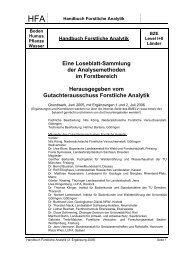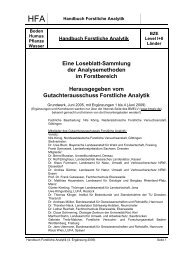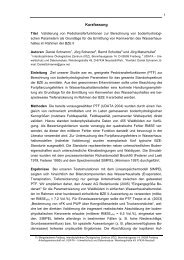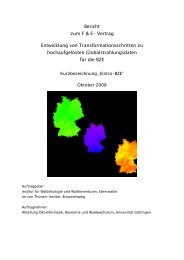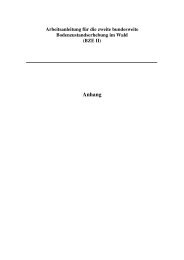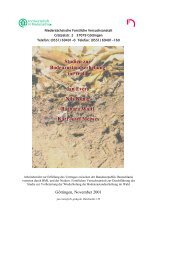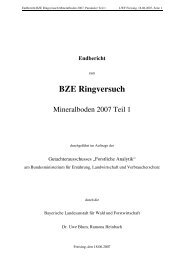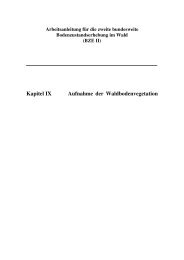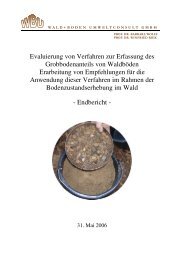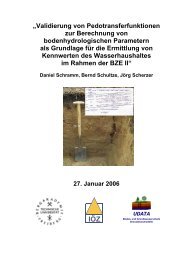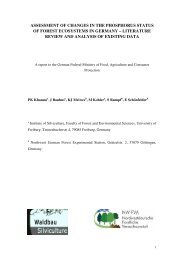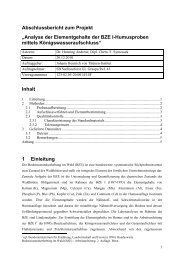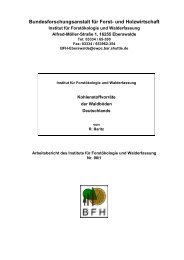assessment of changes in the phosphorus status of forest ...
assessment of changes in the phosphorus status of forest ...
assessment of changes in the phosphorus status of forest ...
Create successful ePaper yourself
Turn your PDF publications into a flip-book with our unique Google optimized e-Paper software.
2.3 Factors <strong>in</strong>fluenc<strong>in</strong>g <strong>the</strong> foliage P concentrations <strong>in</strong> trees<br />
Species<br />
Phosphorus concentrations <strong>in</strong> <strong>the</strong> foliage differ among various tree species, commonly<br />
high P values are found <strong>in</strong> deciduous trees and low <strong>in</strong> coniferous species. For<br />
example, us<strong>in</strong>g <strong>the</strong> data from stands which describe <strong>the</strong> optimum or sufficiency levels<br />
<strong>of</strong> P <strong>in</strong> <strong>the</strong> foliage, Krauß and He<strong>in</strong>sdorf (2005) suggested that <strong>the</strong> different species<br />
can be grouped <strong>in</strong>to <strong>the</strong> follow<strong>in</strong>g <strong>the</strong> order:<br />
(a) High range (>2 mg P/g) <strong>in</strong> Populus balsamifera, Tilia cordata, Carp<strong>in</strong>us betulus<br />
and Betula pendula<br />
(b) Medium range (1.5 to 2 mg/g) <strong>in</strong> Quercus robur, P<strong>in</strong>us strobus, Larix decidua,<br />
Pseudotsunga menziesii<br />
(c) Low range (1.0 to 1.5 mg P/g) Quercus rubra, Fagus silvatica and P<strong>in</strong>us nigra,<br />
Picea abies, P<strong>in</strong>us sylvestris<br />
Thus <strong>the</strong> four species be<strong>in</strong>g considered more closely here could be ranked <strong>in</strong> <strong>the</strong><br />
follow<strong>in</strong>g order <strong>of</strong> decl<strong>in</strong><strong>in</strong>g foliage P demand: Oak > Beech > spruce > p<strong>in</strong>e, with<br />
very little difference between spruce and p<strong>in</strong>e <strong>in</strong> <strong>the</strong>ir P foliage concentrations.<br />
If <strong>the</strong> median values given <strong>in</strong> Table 1 for <strong>the</strong> optimum range are considered (van den<br />
Burg data), <strong>the</strong> four species follow <strong>the</strong> order: Oak = spruce > p<strong>in</strong>e >beech with very<br />
little difference among <strong>the</strong> species. In fact, while consider<strong>in</strong>g <strong>the</strong> <strong>forest</strong> foliar<br />
chemistry surveys on level I sites <strong>of</strong> 16 European countries (1995 survey), an expert<br />
panel decided to consider three classes for p<strong>in</strong>e and spruce (2.0 mg<br />
P/g), for beech (1.7 mg P/g) and for oak stands (1.8 mg<br />
P/g) (Stefan et al 1997 (EC-UN/ECE)), which does not differentiate much between<br />
<strong>the</strong> species. Interest<strong>in</strong>gly, <strong>the</strong> expert panel decided not to assign specific names or<br />
descriptions to <strong>the</strong>se classes <strong>in</strong> order to avoid mis<strong>in</strong>terpretations or wrong<br />
conclusions.<br />
Tree age<br />
The data compiled by van den Burg (1985, 1990) differentiate between mature and<br />
young stands and those from experiments, presumably seedl<strong>in</strong>gs or sapl<strong>in</strong>gs from<br />
greenhouse trials, for a large number <strong>of</strong> cases (Table 2). The range <strong>in</strong> <strong>the</strong><br />
concentration <strong>of</strong> P is very high for each group <strong>of</strong> trees with much overlap. However,<br />
when <strong>the</strong> median and <strong>the</strong> mean values are compared, it shows that <strong>the</strong>re are many<br />
23



